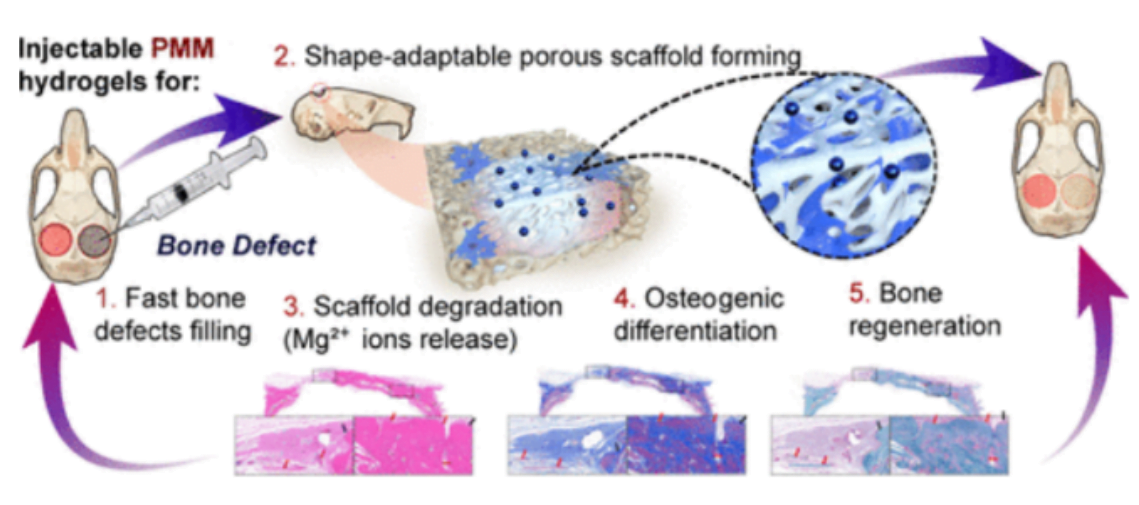Breakthrough Bone Regeneration: Special Hydrogel Mimics Natural Environment for Recovery
Bone defects resulting from physical trauma, tooth extraction, gum disease, inflammation around dental implants, and tumor resection pose a significant challenge in clinical medicine. Small bone defects, such as fractures, heal spontaneously, but large bone defects require extensive treatment. An innovative hydrogel developed at Tel Aviv University has shown promising results in animal models and has extensive clinical applications in both orthopedic and dental medicine.The classical method of restoring bone tissue volume involves the use of a bone graft and a barrier membrane, as shown in the illustration below. However, this method is not always applicable and necessary in every case. This article aims to provide a comprehensive understanding of the hydrogel’s groundbreaking technology and its potential clinical applications.
Hydrogel Research and Technology
The fibrous hyaluronic acid-Fmoc-diphenylalanine-based hydrogel developed at Tel Aviv University mimics the natural substances in the extracellular matrix of bones, stimulating bone growth, and reactivating the immune system to accelerate the healing process.
Prof. Adler-Abramovich: “Small bone defects, such as fractures, heal spontaneously, with the body restoring the lost bone tissue. The problem begins with large bone defects. In many cases, when substantial bone loss results from tumor resection (removal by surgery) , physical trauma, tooth extraction, gum disease or inflammation around dental implants, the bone is unable to renew itself. In the current study, we developed a hydrogel that mimics the natural substances in the extracellular matrix of bones, stimulating bone growth and reactivating the immune system to accelerate the healing process.”
The extracellular matrix is a substance surrounding our cells, providing them with structural support. Every type of tissue in our body has a specific extracellular matrix consisting of suitable substances with the right mechanical properties. The new hydrogel has a fibrillary structure that mimics that of the extracellular matrix of the natural bone. Furthermore, it is rigid, thus enabling the patient’s cells to differentiate into bone-forming cells. The results of the study were published in an article in the Journal of Clinical Periodontology.
To investigate these properties, researchers grew cells in a 3D gel model. They then studied the effect of the hydrogel on animal models with large bone defects that could not heal spontaneously. They observed them for two months using various methods, including micro-CT. Remarkably, the bone defects were fully repaired through regeneration, the bones regained their original thickness, and new blood vessels were formed.
How the Hydrogel Works
The hydrogel developed by Prof. Lihi Adler-Abramovich and Dr. Michal Halperin-Sternfeld, in collaboration with Prof. Itzhak Binderman, Dr. Rachel Sarig, Dr. Moran Aviv, and researchers from the University of Michigan in Ann Arbor, stimulates bone growth and reactivates the immune system to accelerate the healing process. The gel mimics the natural bone’s extracellular matrix, providing structural support to the cells and allowing them to differentiate into bone-forming cells. Hydrogel is stiff with a high elastic modulus of 46 kPa, making it an ideal option for patients with significant loss of bone mass due to various diseases.
The hydrogel (FmocFF)/HA is prepared specifically for each clinical case and is placed in the cavity of the bone defect using surgical methods. During tissue healing and transformation, it is completely absorbed by the body.
Prospects for the use of hydrogel
The innovative hydrogel has extensive clinical applications in both orthopedic and dental medicine. When teeth are lost due to extensive damage or bacterial infections, the standard treatment involves dental implants. However, implants must be anchored in a sufficient amount of bone, and when bone loss is too substantial, physicians may implant additional bone from a healthy part of the body, which is a complex medical procedure. Another option is adding bone substitutes from either human or animal sources, but these might generate an immune response.
The hydrogel developed at Tel Aviv University offers a faster, safer, and simpler solution to bone restoration. The hydrogel can correct large bone defects resulting from tumor resection, physical trauma, tooth extraction, gum disease, or inflammation around dental implants. The hydrogel can be used to regenerate the lost bone tissue, and the bones regain their original thickness and generate new blood vessels.










